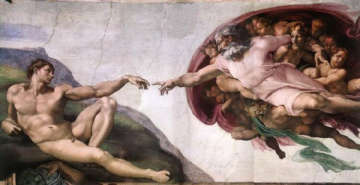5.4 Structure and Composition
 Michelangelo‘s painting of the ceiling of the Sistine Chapel shows the creation of the stars and planets as described in the first chapter of Genesis.
Michelangelo‘s painting of the ceiling of the Sistine Chapel shows the creation of the stars and planets as described in the first chapter of Genesis.
Structure
Genesis 1 consists of eight acts of creation within a six day framework. In each of the first three days there is an act of division: Day one divides the darkness from light; day two, the waters from the skies; and day three, the sea from the land. In each of the next three days these divisions are populated: day four populates what was created on day one, and heavenly bodies are placed in the darkness and light; day five populates what was created on day two, and fish and birds are placed in the seas and skies; finally, day six populates what was created on day three, and animals and man are placed on the land. On day zero primeval chaos reigns and on day seven there is cosmic order.
Genesis 2 is a simple linear narrative, with the exception of the parenthesis about the four rivers at Genesis 2:10-14. This interrupts the forward movement of the narrative and possibly is an expansion on the spring or stream mentioned in Genesis 2:6. The two are joined by Genesis 2:4a. This echoes the first line of Genesis 1, “In the beginning Yahweh created both the heavens and the earth,” and is reversed in the next line of Genesis 2, “In the day when Yahweh Elohim made the earth and the heavens…”. The significance of this, if any, is unclear, but it does reflect the preoccupation of each chapter, Genesis 1 looking down from heaven, Genesis 2 looking up from the earth.
Composition
According to the Jewish tradition the first five books of the Bible were written by Moses. Today virtually all scholars accept that the Pentateuch “was in reality a composite work, the product of many hands and periods.”
Differences among Priestly and Yahwist accounts of creation are said to include these:
- Genesis 1 (Priestly) has creation in the order: plants; sea creatures and birds; land animals; man and woman (together); in Genesis 2 (Yahwist) the sequence is: man; plants; land animals and birds; woman.
- Genesis 1 refers to God as Elohim, Genesis 2 uses the composite name Yahweh Elohim (Yahweh is often translated “LORD,” but does not have this meaning in Hebrew – it is, rather, the name of the God of Israel). The Documentary hypothesis asserts that the two segments using different words for God indicates different authorship and two distinct narratives.
- Though not so obvious in translation, the Hebrew text of the two sections differ both in the type of words used and in stylistic qualities. The first section flows smoothly, whereas the second is more interested in pointing out side details, and does so in a more point of fact style.

Michelangelo‘s The Creation of Adam (1512) is the most famous Fresco in the Sistine Chapel


Be First to Comment